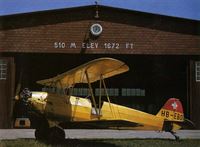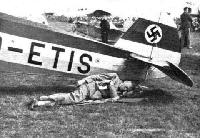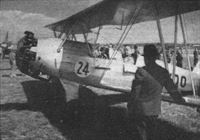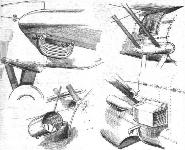
Focke-Wulf Fw 44 Stieglitz
Вторым за Fw-190 по известности самолетом "Focke-Wulf" несомненно является A 44 (Fw 44) Stieglitz, первый полет на прототипе которого в конце лета 1932 года выполнил Герд Ахгелис. Оснащенный мотором Siemens Sh.14а самолет представлял собой одностоечный биплан; каркас фюзеляжа изготовлен из стальных труб и обтянут полотном, крыло - деревянное с полотняной и фанерной обшивкой. Летные характеристики прототипа оказались неудовлетворительными, но в результате интенсивных летных испытаний под руководством Курта Танка, который пришел на фирму в 1931 году с BFW, все недостатки удалось устранить. К. Танк возглавил отдел конструирования и летных испытаний "Focke-Wulf", в то время как Фокке полностью переключился на вертолетную тематику. Stieglitz пользовался огромной популярностью у пилотажников. Герд Ахгелис, Эмиль Кропф и Эрнст Удет творили на нем в воздухе такие чудеса на виражах, что в немалой степени способствовало получению экспортных заказов из Чили, Боливии, Китая, Чехословакии, Финляндии, Румынии, Швейцарии и Турции. Лицензионное производство было налажено в Аргентине, Австрии, Бразилии, Болгарии и Швеции. В огромных количествах Stieglitz строился для нужд Люфтваффе, где он использовался как учебно-тренировочный вплоть до окончания Второй мировой войны. В предвоенные годы самолеты данного типа использовались в летной школе "Deutsche Verkehrsfliegerschule" и в спортивном обществе "Deutsche Luftsportverband".
Варианты
Fw 44B/E: два прототипа с рядным мотором Argus As 8 мощностью 135 л.с. (101 кВт), небольшое количество поставлено Люфтваффе
Fw 44C/D/F: основные серийные варианты с небольшими отличиями в бортовом оборудовании, все оснащены мотором Siemens Sh.14a
Fw 44J: последний серийный вариант, также с мотором Siemens Sh.14a
ТАКТИКО-ТЕХНИЧЕСКИЕ ХАРАКТЕРИСТИКИ
Focke-Wulf Fw 44C
Тип: двухместный учебно-тренировочный самолет
Силовая установка: один 7-цилиндровый звездообразный мотор Siemens Sh.14a мощностью 150 л. с. (112 кВт)
Летные характеристики: макс. скорость 184 км/ч; крейсерская скорость 172 км/ч; практический потолок 3900 м; дальность полета 675 км
Масса: пустого 525 кг; максимальная взлетная 900 кг
Размеры: размах крыла 9,00 м; длина 7,30 м; высота 2,70 м; площадь крыла 20,00 мг
Описание:
- Focke-Wulf Fw 44 Stieglitz
- Flight, November 1934
THE FOURTEENTH PARIS AERO SHOW
Фотографии
-
Air International 2020-01 / D.Unwin - Historic Aircraft Belong in the Air /At the Controls/
Регистрационный номер: D-2692 Only when an aircraft is in flight is it in its natural element.
-
Aeroplane Monthly 1979-03
Регистрационный номер: OY-DVW TORKILD BALSLEV's front cover photograph depicts Focke Wulf Stieglitz OY-DVW over London in September 1974.
-
Aeroplane Monthly 1984-12 / Focke-Wulf Fw 44J Steiglitz OH-SZO /Preservation Profile/
Регистрационный номер: OH-SZO [6], SZ-4 [6] Focke-Wulf Fw 44J Stieglitz OH-SZO is preserved by the Finnish Air Force at Halli, Finland and it was photographed in July this year by ISMO RITARANTA. The aircraft is painted in authentic World War Two markings and is being flown by Jyrki Laukkanen.
-
Aviation Historian 25 / P.Davidson - Off the Beaten Track...
Регистрационный номер: SZ-18 Focke-Wulf Fw 44J SZ-18 was restored during 2002-08 and now hangs in the Tuulonen shopping centre at Tuulos, about 60 miles (100km) north of Helsinki.
-
Aeroplane Monthly 1996-11 / M.Oakey - Vintage news
Регистрационный номер: SE-BWM, SE-BWU, SE-EGT A rare sight at Lyungbyhed on August 25, 1996: three Fw 44 Steiglitzes in a row.
-
Aeroplane Monthly 1999-05 / M.Hooks - Personal album /Archive colour/
Регистрационный номер: HB-EBO, D-EBOB Focke-Wulf Stieglitz HB-EBO outside one of Berne’s oldest hangars on July 3, 1964, was a Swedish-built example and came to Switzerland ex D-EBOB in September 1958. Cancelled seven years later, it appeared in Luxembourg as LX-OOI in April 1966.
-
Мировая Авиация 132
Регистрационный номер: D-EUKA Сиденье инструктора на Fw 44 откидывалось вперед для доступа к багажному отсеку, в кабине имелось место и для парашютов.
-
Jane's All the World Aircraft 1980 / Encyclopedia of Aviation - Aircraft A-Z - v3
Focke-Wulf Fw 44 Stieglitz biplanes.
-
Flight 1934-05 / Flight
Регистрационный номер: D-2911, D-2984 The visiting machines on the tarmac at Heston.
-
Flight 1935-08 / Flight
Регистрационный номер: D-ETIS [2] A group of the visiting German aeroplanes. On the right is the "Stieglitz" in which Herr Furster aerobatted so efficiently.
-
Flight 1936-09 / Flight
Регистрационный номер: D-ETIS [2] Herr Forster steals forty winks under the protection of the Swastika.
-
Flight 1938-06 / Flight
Регистрационный номер: D-EVQO [2] The scene on and beyond the tarmac at Hatfield before the machines were taxied out to the starting line. The change in the weather conditions between start and finish is obvious.
Другие самолёты на фотографии: Messerschmitt Bf.108 Taifun - Германия - 1934
-
Flight 1938-06 / Flight
Регистрационный номер: D-EVQO [2] Herr Gerbrecht, in the Focke-Wulf F.W.44, was second in the Manx Air Derby at 108.45 m.p.h.
-
Aeroplane Monthly 1997-03 / ??? - Interned! (2)
Регистрационный номер: HB-EBN [2] Deliberately fleeing to Switzerland, Focke-Wulf Fw 44F Stieglitz NV+KF, Werknummer 462, was the only example to land there, arriving at Dubendorf from Constance on April 26,1945. That summer it was bought from the Allied Control Commission, becoming A-95 in Swiss military service. Civilionised as HB-EBN in June 1953, it was broken up in December 1965.
-
Авиация и Космонавтика 1997-10 / И.Кудишин - Кладовка для самолетов
Один из немногих зарубежных экспонатов музея - немецкий Фокке-Вульф FW-44 "Штиглиц". Перед войной он предлагался американцам в качестве учебного самолета, вот и попал в музей
-
Aeroplane Monthly 1985-07 / B.Johnson - Flugkapitan Hanna Reitsch. 1914-1979 (2)
Fw 44 Stieglitz trainer, operated by A/B 23 Kaufbeuren, photographed at Kempten-Durach in 1940.
-
Aeroplane Monthly 1991-01 / E.Shackleton - Farewell Harlingen
Регистрационный номер: N2497 Focke-Wulf Fw 44 Stieglitz N2497 with its uncowled Siemens radial engine.
-
Flight 1937-06 / Flight
The Final of the handicap race: the winning Klemm 35 (Tolxis) and the Focke Wulf 44 (von Braun) turning away from each other after they had crossed the line.
Другие самолёты на фотографии: Klemm Kl.35 / Kl.106 - Германия - 1935
-
Flight 1937-07 / Flight
Gerd Achgelis covers the aerodrome with smoke during his low-altitude aerobatic work in a Focke-Wulf Stieglitz.
-
Flight 1937-09 / Flight
Beating the band: Herr Paul Forster (F. W. Stieglitz) concludes his performance with a not-too-emotioning inverted fly-past. We are slowly becoming accustomed to that sort of thing.
-
Flight 1936-09 / Flight
Herr Paul Forster in action with his Focke-Wulf Stieglitz.
-
Jane's All the World Aircraft 1938 / 03 - All the world's aeroplanes
The Focke-Wulf "Steiglitz" Two-seat Training Biplane (150 h.p. Siemens Sh.14A engine).
-
Air Pictorial 1958-03 / Air Pictorial's photo-review
Регистрационный номер: D-EMIG Another immaculate tandem two-seater, a mid-1930s' vintage Focke-Wulf Fw 44J Steiglitz (D-EMIG). The Fw 44J Steiglitz is powered by a 150-h.p. Siemens Sh 14A radial.
-
Air Enthusiast 2001-09 / C.Lucchesi - For Naval 'Wings'
Licence-built Focke-Wulf Fw 44J Stieglitz, 41 of which were operated by the Brazilian Navy.
-
Jane's All the World Aircraft 1938 / 03 - All the world's aeroplanes
A Swedish-built Focke-Wulf "Stieglitz" Two-seat Training Biplane.
-
Jane's All the World Aircraft 1938 / 02 - The progress of the world in military aviation during the year 1937-38
Focke-Wulf Trainers of the Swedish Air Force.
-
Flight 1938-09 / Flight
Some of Sweden’s Gloster Gladiators come in over a line of F. W. Stieglitz trainers.
Другие самолёты на фотографии: Gloster Gladiator - Великобритания - 1934
-
Aeroplane Monthly 1976-12 / T.Olausson - Swedish Internees (1)
Four Mosquitoes are visible in this group on the Satends apron in 1945. Also visible are a Northrop 8A-1 (B5) target tug and a Focke-Wulf Fw-44J Steiglitz (Sk-12) trainer, both of the Swedish Air Force. The nearest Mosquito is engineless.
Другие самолёты на фотографии: De Havilland Mosquito F - Великобритания - 1941Northrop A-17 / 8A Nomad - США - 1934
-
Air Pictorial 1956-01 / Air Pictorial's photo-review
Регистрационный номер: LV-YZM An Argentine-registered Focke-Wulf Fw 44J Stieglitz two-seat aerobatic biplane which was seen in England last summer.
-
Air Pictorial 1956-06 / Air Pictorial's photo-review
Регистрационный номер: HB-EBN [2] Unusual combination Bucker Bu 133 Jungmeister-type cowling over the 150-h.p. Siemens Sh 14A radial of a normally uncowled Focke-Wulf Fw 44(F) Steiglitz.
-
Aeroplane Monthly 1984-12 / Focke-Wulf Fw 44J Steiglitz OH-SZO /Preservation Profile/
Регистрационный номер: OH-SZO [6], SZ-4 [6] As OH-SZO at Rayskala in July 1969.
-
Aeroplane Monthly 1984-12 / Focke-Wulf Fw 44J Steiglitz OH-SZO /Preservation Profile/
Регистрационный номер: OH-SZO [6], SZ-4 [6] ISMO RITARANTA’s plate shows the aircraft being flown by Jyrki Laukkanen in July 1984 in World War Two markings.
-
Aeroplane Monthly 1982-12 / Skywriters
Регистрационный номер: SZ-4 [6], OH-SZO [6] The SZ-4 has been preserved in flying condition by the Finnish Air Force.
-
Aeroplane Monthly 1984-12 / Focke-Wulf Fw 44J Steiglitz OH-SZO /Preservation Profile/
Регистрационный номер: SZ-4 [6], OH-SZO [6] The blue swastikas were changed to blue-white roundels on April 1, 1945.
-
Aeroplane Monthly 1984-12 / Focke-Wulf Fw 44J Steiglitz OH-SZO /Preservation Profile/
Регистрационный номер: SZ-4 [6], OH-SZO [6] SZ-4 has suffered three major accidents, the first of which was during the war.
-
Flight 1934-11 / Flight
A selection of oil coolers: (top left) Farman 431; (top right) P.Z.L. 24; (bottom left) Focke-Wulfe; (bottom right) Potez 54.
Другие самолёты на фотографии: Farman F.430 - Франция - 1934Potez Potez 54 - Франция - 1933PZL P.24 - Польша - 1933
- Фотографии



































